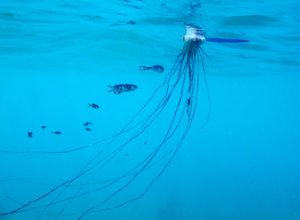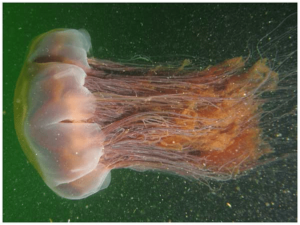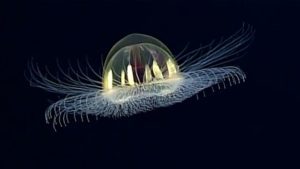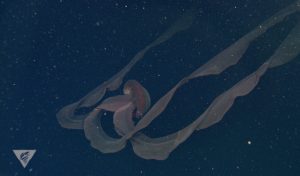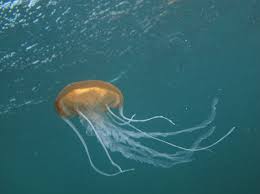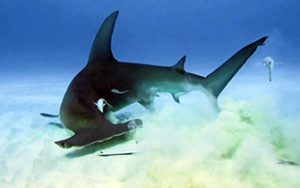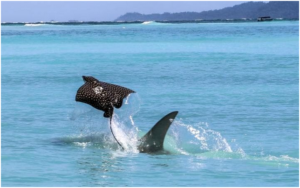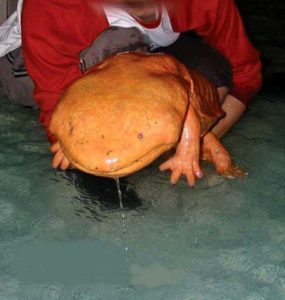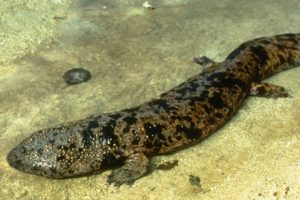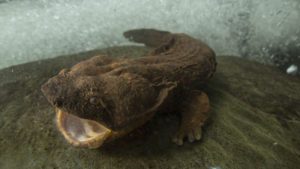Podcast: Play in new window | Download (Duration: 21:19 — 19.0MB)
We’re talking about Thunderbird this week and the huge North American birds that may have inspired Thunderbird’s physical description. Thanks to Desmon of the Not Historians podcast for this week’s topic suggestion!
Further listening:
While I was in the middle of researching this episode, Thinking Sideways did a whole episode on Washington’s Eagle.
Further reading:
“The Great Quake and the Great Drowning”
“The Myth of 19th Century Pterodactyls”
Depiction of Thunderbird on a Pacific Northwest totem pole:

A wandering albatross hanging out with a lot of lesser birds. Biggest wingspan in the world right here, folks!
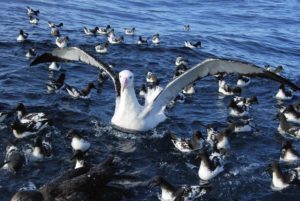
A California condor. #16, in fact.
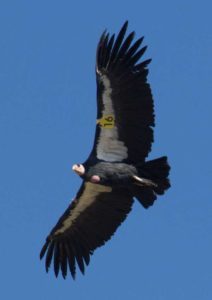
An adult bald eagle with a juvenile.

Washington’s eagle as painted by James Audubon

Model of a teratorn. We don’t actually know what colors they were.

Show transcript:
Welcome to Strange Animals Podcast. I’m your host, Kate Shaw.
This week’s episode about Thunderbirds was suggested by Desmon of the Not Historians Podcast, a fun, fascinating podcast about history. If you haven’t given it a listen yet, I recommend it.
Despite my interest in birds, before I started research for this episode, I didn’t know much about the Thunderbird. I knew it was an element in First Nations lore but I didn’t know which tribes or regions, just assumed it was out west somewhere. Since I live in East Tennessee, “out west” to me is a vague wave of the hand and a mental image of wide-open plains and buffalo and maybe John Wayne. But it turns out that the Thunderbird is an important element in Northeastern and Pacific Northwest tribal lore, as well as being well known among the Great Plains societies and beyond. Thunderbird, in fact, is one of the most widespread figures in Native American lore.
I’m always cautious when mystery animal research points me to religious lore. Many cryptozoologists like to mine myths, legends, folktales, and religious stories of all kinds to find corroboration for the existence of their personal pet cryptid, but if you aren’t extremely well versed in the culture, it’s easy to misinterpret elements of a story. Worse, some cryptozoologists do this on purpose, running roughshod over sacred beliefs and yanking out one mention of, for instance, a giant human and then shouting about how this tribe clearly knows all about Bigfoot. Not to pick on the Bigfoot hunters, but guys, you need to calm down.
Thunderbird is associated with storms but it’s not accurate to say he’s a storm god. He’s more of a representation of the uncontrollable power of nature. In many Plains societies, Thunderbird is associated with trickster figures and a deep belief in the dual aspect of nature—that things in nature often hold their own opposites, that everything found in nature is reflected and represented in the human world.
Thunderbird is not necessarily a single being, either. Many tribes have stories about four different varieties of Thunderbird represented by different colors. Sometimes the different colored Thunderbirds correspond to the cardinal directions, sometimes not. And while Thunderbird is generally supposed to be an enormous eagle-like bird, the difference between bird and human is frequently blurred in the stories. This blurring of human and animal traits in stories is true across all cultures, incidentally, and if you doubt me, think about “what big eyes you have, granny.” Animal beings in traditional stories of all types are allegories, not real animals or real people.
The Thunderbird is also an allegory, a spiritual being, and it’s a disservice to the rich and sophisticated First Nations cultures to strip those trappings away and try to find nothing but a bird underneath. That’s not to say the physical form of Thunderbird wasn’t inspired by eagles or other birds. Just don’t dismiss a culture’s spiritual world to root out so-called proof of a natural explanation.
But. That doesn’t mean there aren’t any gigantic honkin birds in North America and throughout the world.
Going by wingspan, the biggest known living bird is the wandering albatross. Its wingspan can exceed 12 feet, with unconfirmed rumors of individuals with wingspans topping 17 feet. That is an enormous wingspan, seriously. I’d love to see one. The wandering albatross looks like an enormous seagull, white with black wings and a pink bill and feet. Males have more white on the wings—sometimes only the wingtips are black—and a peach-colored spot behind the head. Like many seabirds, albatrosses have a salt gland in their nostrils that helps filter excess salt from the body.
The wandering albatross spends most of its life on the wing far out at sea. It can soar for hours without needing to flap its wings. It eats fish and other animals it can catch at the surface of the ocean or in shallow dives, and sometimes will eat so much it can’t fly and has to sit in the water while it digests. I feel that way every time I go to a buffet.
But since the wandering albatross, as well as its somewhat smaller relatives, lives around the southern sea at the south pole, I think we can safely say that it wasn’t an inspiration for Thunderbird. Besides, it’s basically a giant seagull. Not exactly Thunderbird material.
The California condor’s wingspan is ten feet, and many people point at it as a possible Thunderbird model. But the condor is a type of vulture, which means it has a bald head and mostly eats carrion. Vultures evolved bald heads to reduce bacterial growth in their feathers, since yeah, they sometimes stick their heads in dead animal carcasses to get at those yummy soft parts. No matter how magnificent a wingspan the condor has, it doesn’t fit the stories of Thunderbird battling creatures like Horned Snake, since vultures aren’t raptors and their bills and claws are relatively weak. The same holds true for the Andean condor, with a wingspan of eleven feet, not to mention that bird lives in South America.
The trumpeter swan has a wingspan of over ten feet and lives in North America, but while swans can be aggressive, they eat aquatic plants and act like gigantic ducks, not exactly fierce Thunderbird material. The American white pelican likewise has a ten-foot wingspan but, well, it’s a pelican.
So what about North American eagles? We only have two known species, the bald eagle and the golden eagle. Both have wingspans that can reach more than eight feet and, tellingly, both are common throughout the Pacific Northwest and throughout most of North America. It’s entirely possible that admiration of these large eagles gave form to descriptions of the Thunderbird.
But while an eagle with a nine foot wingspan is impressive, let’s not fool ourselves. We all want to know about GIANT HECKIN HUGE BIRDS. Like, twice that size! This is what cryptozoologists so often dig around for in Native Thunderbird legends, hints that there was once and maybe still is a bird so enormous that it inspired terror and awe in people who saw it, to the degree that they immortalized it in cultures throughout North America as the Thunderbird.
In cultures without written language, stories impart knowledge of everything—history as well as religion, warnings of real-life dangers as well as rituals to ward off the danger—and many stories serve dual purposes. Among the Pacific Northwest peoples, certain stories about Thunderbird battling Whale commemorate a cataclysmic event now known to science, a violent earthquake on Jan. 16, 1700. It was probably a magnitude 9 quake that dropped the coast as much as six and a half feet and resulted in tsunami waves drowning villages from northern California to southern Vancouver Island. In the 1980s a team of researchers studying the geology of the area looked closely at stories of the Makah people in Washington state. Soon they learned that all the indigenous peoples along the coast had stories about the earthquake.
The difference between that study and cryptozoologists looking for Bigfoot or a real-life Thunderbird is one of training and intent. The 1980s team consisted of anthropologists, geologists, and indigenous scholars. And they weren’t cherrypicking information that matched what they had already decided was the truth. What they discovered among the Pacific Northwest peoples guided their research and helped them learn more about the infrequent but violent earthquakes in the area. They even uncovered stories that may be about older quakes and tsunamis.
The problem is that stories about events that happened a long time ago tend to fall out of circulation eventually, especially if the events are no longer relevant. The earthquake stories were hard to gather in the 1980s because the event that inspired them happened almost 300 years before. How much can you remember about the year 1700 without looking it up online? And in the meantime, other cataclysms, notably invading Europeans bringing diseases like smallpox, destroyed much of the native culture.
In other words, even if you’re a trained anthropologist with a deep understanding of the cultures you’re studying, teasing historical information about giant birds from Native American stories is next to impossible. We know truly gigantic birds used to exist in North America because we’ve found their remains, but we can never know for certain if any of those birds inspired Thunderbird legends in any way or if the birds were ever even seen by humans.
Some of the largest flying birds that ever lived are known as pseudotooth birds because their beaks had toothlike spines. They were big, slender birds that probably looked a lot like albatrosses although at the moment they’re classified as more closely related to storks and pelicans. While we don’t have any complete skeletons, researchers estimate the birds’ wingspans may have been as much as 20 feet. One species, Pelagornis sandersi, may have had a wingspan as wide as 24 feet. I just went outside and measured the road in front of my house, and it’s only about 18 and a half feet wide, just to put that into perspective. It’s probable the pseudotooth birds weren’t actually able to flap their wings, just soar.
Like albatrosses, the pseudotooth birds probably covered vast distances in flight. Their remains have been found in North and South America, New Zealand, parts of Africa and Europe, Japan, even the Antarctic. They ate whatever they could scoop up from the water with their long bills. The toothlike projections on their bills weren’t very strong and just helped the bird keep hold of wriggly fish, but they certainly look impressive.
But from what we know from the fossil record, the pseudotooths all died out by the early Pleistocene, some two million years ago. Homo habilis may have seen them flying off the coast of Africa, and if so I bet our distant ancestors thought something like, “Wow, that’s a huge bird!”
The group of North American birds that a lot of cryptozoologists want to call the Thunderbird is the teratorns. Some of them were as big as pseudotooth birds with 20-foot wingspans, but they looked much different. They’re related to the New World vultures, but their bills are more eagle-like, indicating that teratorns were active hunters that could probably swallow prey as large as rabbits whole. Formerly some researchers thought the biggest teratorns couldn’t fly, but new discoveries of fossils with contour feather attachment marks indicate they could. But since teratorns had long, strong legs as well, they might have sometimes stalked their prey on foot the way golden eagles occasionally do.
We have a lot of teratorn remains from the La Brea tar pits. Teratornis merriami had a wingspan of about 12 feet and lived until only about 10,000 years ago. The biggest teratorn is Argentavis magnificens, which lived in South America and probably went extinct around 6 million years ago. It had a wingspan of at least 20 feet, possibly more than 25 feet, but we don’t have very many fossils of this bird. Only one humerus has been discovered—that’s the upper arm bone, and it’s the length of an entire human arm.
It would be truly magnificent if a teratorn descendent still existed. Some people think it did, at least until a few hundred years ago. We might even have a depiction of one by the most famous bird artist in the world, James Audubon.
In February 1814, Audubon was traveling on a boat on the upper Mississippi River when he spotted a big eagle he didn’t recognize. A Canadian fur dealer who was with him said it was a rare eagle that he’d only ever seen around the Great Lakes before, called the great eagle. Audubon was no slouch as a birdwatcher and was familiar with bald eagles and golden eagles. He was convinced this great eagle was something else.
Audubon made four more sightings over the next few years, including at close range in Kentucky where he was able to watch a pair with a nest and two babies. Two years after that, he spotted an adult eagle at a farm near Henderson, Kentucky. Some pigs had just been slaughtered and the eagle was probably coming by to look for scraps. Audubon shot the bird and took it to a friend who lived nearby, an experienced hunter, and both men examined the body carefully.
According to the notes Audubon made at the time, the bird was a male with a wingspan of 10.2 feet. Since female eagles are generally larger than males, that means this 10-foot wingspan was likely on the smaller side of average for the species. It was dark brown on its upper body, a lighter cinnamon brown underneath, with a dark bill and yellow legs.
Audubon named the bird Washington’s eagle after George Washington and used the specimen as a model for a lifesized painting. Audubon was meticulous about details and size, using a double-grid method to make sure his bird paintings were precisely exact. This was long before photography, remember.
So we have a detailed painting and first-hand notes from James Audobon himself about an eagle that…doesn’t appear to exist.
Now, this isn’t the only bird Audubon painted that went extinct afterwards. He painted the ivory-billed woodpecker, subject of our episode nine, and the passenger pigeon, along with less well known birds like Bachman’s warbler and the Carolina parakeet. Yeah, North America used to have its very own budgie that was cute as heck, but it’s long gone now.
To add to the confusion, though, Audubon also made some mistakes. Selby’s flycatcher? Nope, that was just a female hooded warbler. Many people think Washington’s eagle was just an immature bald eagle, which it resembles.
I don’t actually agree. I’m just going to say that right out. Let me explain why.
There are reports of bald eagles with wingspans of nine feet, although I couldn’t find any verified measurements that long. A bald eagle will actually have a slightly wider wingspan as a juvenile than as an adult because of the way its feathers are arranged, but that difference is a matter of a few inches, not feet. In addition, the largest bald eagles are found in Alaska; individuals in the southeastern United States are usually much smaller. And female bald eagles are typically as much as 25% larger than males.
But here we have a male eagle shot in Kentucky with a measured wingspan of 10.2 feet. Juvenile bald eagles do travel widely, but even if that happened to be an outrageously large individual who’d flown down from Alaska, consider that Audubon had seen the same type of eagle nesting a few years before near the same area. He’d watched a pair feeding two chicks. Immature bald eagles don’t nest or lay eggs. There are other differences too, notably the color and size of the nostril area and the type of scaling on the legs.
Golden eagles also resemble juvenile bald eagles to some degree, but they don’t nest in Kentucky. Their winter range just barely touches Kentucky, in fact. They nest in Canada and in the western half of the United States. And the largest golden eagle ever measured was a captive-bred female with a 9.3 foot wingspan, and like bald eagles, golden eagle females tend to be considerably larger than males. A male with a wingspan of over ten feet is probably not too likely; but even if an aberrantly large male golden eagle decided to vacation a little farther south than usual, it’s clear from many details in Audubon’s painting and in his notes that the bird he shot can’t be a golden eagle.
Audubon kept diaries of his birding trips so we know he was familiar with juvenile bald eagles—he even painted one. We also know he differentiated between juvenile bald eagles and Washington’s eagle, which he wrote was about a quarter larger than the juvenile bald eagle.
And Audubon wasn’t the only person to have reported the eagle. From other reports we know it hunted differently from bald eagles, including no reports of it stealing fish from ospreys the way bald eagles frequently do (the jerks). Washington’s eagle reportedly preferred to nest in rocky cliffs near water, not in trees like bald eagles.
So I don’t think Audubon was mistaken or lying. I think he really did paint a type of eagle that was already rare in the early 19th century and which went extinct soon after. Unfortunately, Audubon’s mounted specimen has been lost, but it’s always possible there are other specimens floating around in personal collections or museum storage rooms, possibly mislabeled as juvenile bald eagles.
There’s not a very good chance that Washington’s eagle survived into the present day just because its immense size would make it easy to spot. Then again, size is really hard to estimate without something of known size to compare it to. Is it a gigantic eagle that’s really high up or an ordinary eagle at a closer distance? Combine that with Washington’s eagle looking so much like a juvenile bald eagle and there could be a remote population hiding in plain sight.
There are, of course, lots of reports of giant birds in North America. Most take place along roads or in back yards, where people catch glimpses of eagles of unbelievable proportions—literally unbelievable, in fact, 15 or 20 or even 25-foot wingspans and birds that pick up deer and fly off with them. Most of these are probably misidentifications of known birds of prey with size exaggerated due to alarm, poor visibility, or just an inability to estimate size correctly. Some may be hoaxes. But there’s always the possibility that in this case we might really have a very rare, very large eagle still living in remote areas of Canada or Alaska, and occasionally one flies into more populated areas.
Let’s hope someone finds some remains, either taxidermied specimens or a collection of bones and feathers in some protected cave, so they can be tested and we can find out if there’s a real live teratorn still flying around—or at least learn if there are three species of eagle in North America instead of just two.
I don’t know if Washington’s eagle has anything to do with the Thunderbird. In my mind they feel like two completely separate entities: a flesh and blood eagle circling high above a lake in search of prey, and a terrifying being wrapped in storm clouds soaring somewhere between reality and the spirit world. Some birds are bigger than others, and some birds have to be taken on faith.
You can find Strange Animals Podcast online at strangeanimalspodcast.blubrry.net. That’s blueberry without any E’s. We’re on Twitter at strangebeasties and have a facebook page at facebook.com/strangeanimalspodcast. If you have questions, comments, or suggestions for future episodes, email us at strangeanimalspodcast@gmail.com. We also have a Patreon if you’d like to support us that way.
Thanks for listening!
